DFI CFX3200-DR: ATI RD580 Tweak Attack
by Wesley Fink on May 8, 2006 12:05 AM EST- Posted in
- Motherboards
General Performance
With the Memory Controller on the Athlon 64 Processor, Winstones benchmarks are no longer very revealing of motherboard performance. With the same CPU (and the same memory controller on that CPU), Winstones scores - both Business and Multimedia Content Creation - are tightly clustered. The only deviation from that is that boards that are tweaked for best gaming performance are often near the bottom of a tight range of benchmark performance numbers. The Winstones tests themselves are rapidly becoming dated, and are no longer supported by PC Magazine. While Winstones are still useful in providing real world performance data we will soon be dropping them from our motherboard test suite.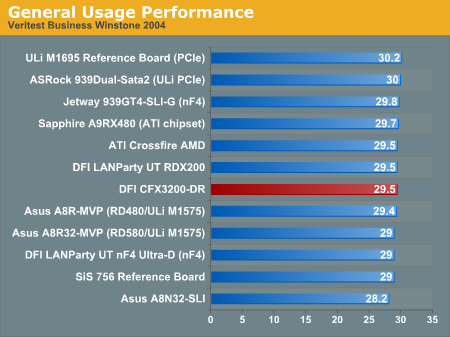
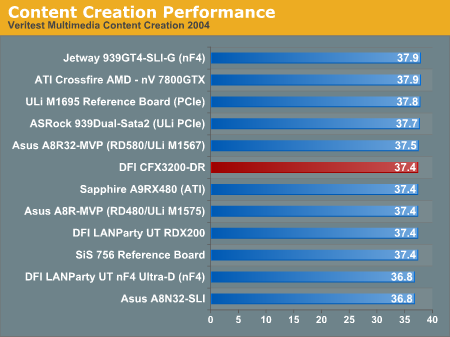
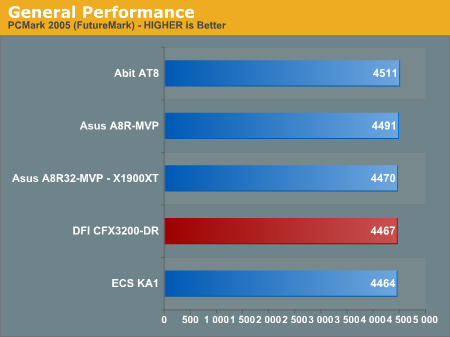
PCMark 2005 results with the DFI CFX3200 were average. Performance of the CFX3200 was in the middle of a tightly clustered group that only ranged from 4464 to 4511. Since all tested boards use ATI chipsets running X1900XT video the performance clustering is expected.
Despite the close results in these tests, PCMark05 is proving to be a useful overall performance benchmark. It is generally more sensitive than the older Winstones and PCMark04 to recent improvements in PC architecture. PCMark05 results in general relate well to the other performance results we find in our board tests, providing a quick and reliable snapshot of board performance compared to other motherboards.
3D Graphics & Encoding
The 3DMark benchmarks, published by Futuremark, are probably the most widely quoted gaming performance benchmarks available. While the benchmarks are based on game sequences written by Futuremark to reveal subtle differences in gaming performance, they still have to be considered synthetic benchmarks. They are useful for broad graphics comparisons, but they are no substitute for benchmarks with real gaming engines that are currently being played.SLI and CrossFire are also generally supported in 3DMarks, so tests were run with both single and dual video cards on all five tested boards. 3DMark06 was recently introduced and you can find more in-depth information about this new 3DMark at in the AnandTech article Futuremark's Latest Attempt: 3DMark06 Tested.
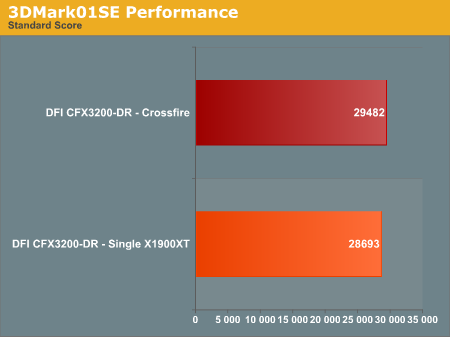
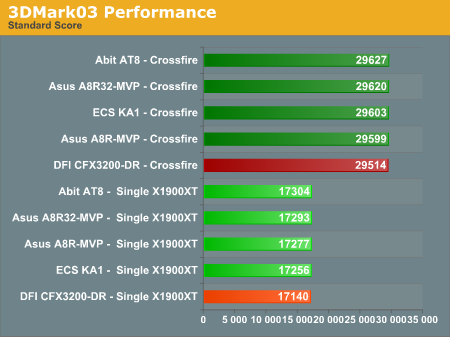
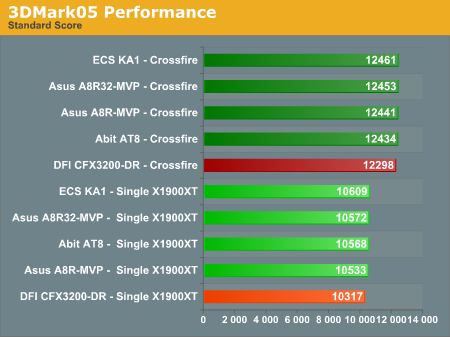
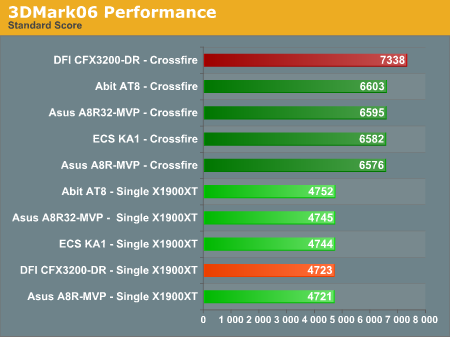
The CFX3200 holds a wide performance lead in CrossFire on 3DMark06 compared to other Rx480 and RD580 motherboards running X1900XT CrossFire. The DFI board does not hold a similar advantage in 3DMark06 when tested with a single X1900XT. 3DMark03 really gains huge performance increases with CrossFire, but results with the DFI are similar to other ATI chipset motherboards in both single and CrossFire modes. The same can be said for 3DMark05, except that CrossFire gains are in the neighborhood of 20% compared to the 70%+ CrossFire gains in 3DM03.
The 03, 05, and 06 are all based on DirectX 9, where 3DMark2001SE is based on DX8. While 3DMark01SE is somewhat dated in DX support it is still widely used by enthusiasts because it is more sensitive to increases in memory bandwidth and CPU speed than later 3DMarks. You can also see that the CrossFire gains in 01SE are very small compared to the DX9 based 3DMarks..
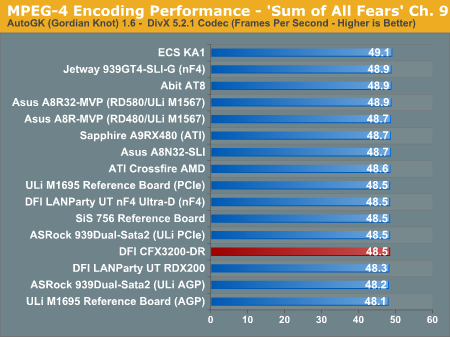
Encoding results should not be affected by the graphics card used during the encoding benchmarks. This is demonstrated again by the archive test results for AutoGK using an AMD 4000+ processor with a wide assortment of video cards. The performance range of those encoding tests is just 48.1 to 49.1 - a difference form high to low of just 1.0 FPS. Clearly the biggest influence on this encoding benchmark is the CPU used for testing. Because encoding test results vary so little on the same standardized motherboard test platform, they will be dropped from future motherboard reviews. Encoding tests are useful in CPU testing, but they have been shown to be poor motherboard tests - particularly on the AMD platform with the memory controller on the CPU.










25 Comments
View All Comments
Stele - Wednesday, May 10, 2006 - link
IMHO the main disadvantage of using the Sil3114 instead of a newer SATA controller like the 3132 is not so much the 1.5Gbps transfer rate, but the fact that it's PCI-based and hence badly bottlenecked once you fill all four channels. 1.5Gbps is a theoretical maximum and HDDs today are nowhere near that limit - in fact we left ATA-133 without even breaking the ATA-100 limit. Since each SATA HDD gets a dedicated 1.5Gbps channel, arrays won't saturate the SATA interface either - rather, they would saturate the slow PCI interface as previously mentioned. Furthermore, the other significant feature of SATA II - NCQ - is of virtually zero relevance to most users, unless one is using the board in a corporate server; not impossible, but not likely either. Therefore, to harp on a figure that has generally been more a marketing tool (as was ATA-133) than a real necessity says little of the real issues at hand.In return, using the Sil3114 means using a tried and tested product whose characteristics are very well known by now. Board engineers would know how best to design around it - what special requirements (signal integrity, trace lengths, coupling etc), if any, need to be factored in, how the controller performs and behaves and so on. Furthermore, the 3114 provides 4 SATA ports for maximum expansion capability - there is no 4-port version of the 3132 as you alluded to in the review - not yet anyway. You may well be right about having a truckload of 3114s to get rid off, so that's likely a factor too. Perhaps when the 3132 gains a 4-port counterpart (and DFI finishes off 3114 inventory) then we may see newer stuff to come. :)
On another side note, yes there would probably be many people who would appreciate the insane options in BIOS, but I do agree that they should make the UI more user-friendly, e.g. by having Automatic as a choice and/or by placing advanced options in sub-menus to distinguish them from the main options. That would satisfy enthusiasts of all levels, from the mad hatters down to the ones who are just starting out. :)
Generally a review well done! :)
Stele - Wednesday, May 10, 2006 - link
Perhaps that statement should be clarified/qualified a little - there is no 4-port version of the 3132 (i.e. PCIe + SATA II + 3.0Gbps) in a single controller IC. The 3132 supports, and hence is expected to be used with, SATA port multipliers - primarily the SII 3726, which can support up to 5 drives. In future, DFI could use a 3132 with one SATA channel routed to an external connector (as in the Asus A8N32-SLI) while the other channel could be connected to a 3726 to provide an additional 4 or even 5 internal HDD channels.
However, this would create two problems - the need for another IC (the board is already very cramped as it is!) and, as already discussed, the need to gain sufficient experience with the new ICs in the lab before they can be confidently implemented and designed around. Cost and time-to-market factors may also have played a role in DFI's choice.
proamerica - Monday, May 8, 2006 - link
This is a poor quality review. The reviewer complains too much about variables that actually improve performance when handled by the right person. The overclocking potential of this board is beyond all other 939 boards I have owned, including the A8R32-MVP... People all over the place are reporting the highest overclocks ever achieved for memory and CPUs. You have to know what you are doing I'm afraid, and yes it requires using all the settings in the BIOS. That is the caveat of buying this board, its hard to use, and it takes time to figure it out, but once you do its worth it. I stably OC'ed my X2 3800 to 2940Mhz, and I currently run it 24/7 at 2700Mhz. Is 2940Mhz the highest OC I have ever gotten with this processor? Yes, stably, by far the highest. One of the greatest aspects of this board is that it will overclock really high but it doesn't take a lot of voltage to get things stable.Why does the review say: "but this DFI does make us wonder how many end users will actually devote the time to master 32 levels of drive strength, and DQS skew levels of +/- 0 to 255 in 511 levels." Lets see, an extremely expensive motherboard from a company known for making the most tweakable boards around... And you wonder if end-users are going to bother? Yeah they're going to bother. If they don't, they should have purchased something else.
Bottom line, this board beats the A8R32-MVP hands down, its just harder to use than the Asus.
Wesley Fink - Tuesday, May 9, 2006 - link
The review pointed out what you clearly found. It's a difficult board to master, but the options and performance can be outstanding. Some want to take the time to master it, others would prefer a board that is easier to overclock. The real poiunt is the DFI CFX3200 still needs work. The BIOS does NOT need to be so difficult to master, and it wouldn't be if more intelligent choices were made for auto settings.The CFX3200 is not a bad board, it is just a very difficult board to use and master - even for an experienced enthusiast.
Zoomer - Wednesday, May 10, 2006 - link
As mentioned by someone else, the auto (default) settings are nicely choosen - for BH5 memory.Perhaps it would be wise to point that out somewhere, or provide an option of memory: BH5/Normal/Valueram/Manual
ozzimark - Monday, May 8, 2006 - link
"Running four double-sided 512MB or 1GB DIMMs is much more demanding than running two DS DIMMs, and like almost every board we have tested the Command Rate needed to drop to 2T with 4 DS DIMMs."using a high dram drive strength should allow for stable opteration at 1T with 4 double rank sticks in.. :)
bigtoe36 - Monday, May 8, 2006 - link
From the Tweak guide on the bleedinedge forum."Max async latency - options 7 thru 10 are all you should need, 7 for agressive tight timings 10 for high fsb overclocks. This option HAS TO BE SET MANUALLY
Read Preamble - 4.5 thru 6 is all you need worry about, 4.5 for BH5 etc and 6 for high fsb overclocks. i usually use 5.5 and 6. Again HAS TO BE SET MANUALLY"
http://www.bleedinedge.com/forum/showthread.php?t=...">http://www.bleedinedge.com/forum/showthread.php?t=... for the full guide.
Wesley you have the options posted on page 4 the wrong way round, its easy to do as I often get them confused.
Tony
ozzimark - Monday, May 8, 2006 - link
with dfi boards, it's long been my experience that manually setting MAL/RP is a VERY BAD thing.bigtoe36 - Monday, May 8, 2006 - link
Normally that would be the case but DFI were setting 4.5 and 5 as hidden defaults. Now if you are running Bh5 you will have no problems, but most everything else would have issues.Thats why i quoted in my guide and on MANY forums you have to set these manually to get the best from the board.
mbhame - Monday, May 8, 2006 - link
Where's the USB/Firewire CPU Utilization and I/O? Where's IDE performance?Throughput is not indicative of real-world performance for any user I know.